Painting upon the Floor – Chinese Baotou Rugs
PRIMITIVE - Friday, November 04, 2016Edited by Glen Joffe
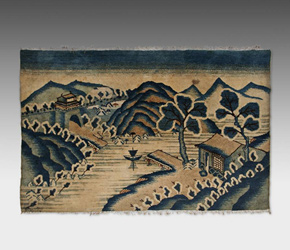 |
|
What comes to mind when you think of traditional Chinese art? Is it porcelain, calligraphy, scholar's rocks or jade carvings? A category of artwork all too often overlooked is Chinese rugs. Surprisingly, there has been little historical documentation of wool weaving traditions in China. Despite the international trade that flourished for centuries, rugs and carpets were rarely exported. Though frequently lumped into the broader category of 'oriental rugs,' textiles woven in China were created mainly for internal consumption. In addition, weaving itself was not considered the equal of other scholarly arts. Nevertheless, collectors in recent years have taken note of distinguished groups of Chinese rugs that stand out as exceptional works of art. Most notable, are picture rugs.
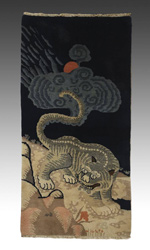 |
|
Chinese wool rugs were traditionally produced in the northern regions where the climate is cold and arid, conditions ideal for raising sheep to provide wool. However, it was also an area subject to continual conflict between the Chinese and nomadic tribes to the north and west. The result was frequent border shifts. Famous centers of weaving were located in Ningxia, Xinjiang and Baotou. Today, those areas are respectively located in the Hui, Uyghur and Inner Mongolia Autonomous Regions of northern China. Some historians argue these rugs should be attributed to Muslim, Turkish and Mongolian ethnic minorities while others point out the undeniable influences of Chinese art. Regardless of how these rugs are perceived, each region has its own unique style and weave – and perhaps most impressive are those coming from Baotou.
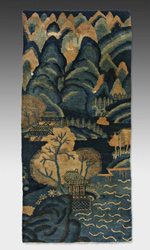 |
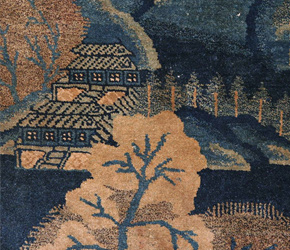 |
|
Baotou is the largest industrial city in the Inner Mongolian Autonomous Region. The city’s Mongolian name means “place with deer.” An alternate name is Lucheng, which means “deer city.” Rugs from Baotou are so decorative and scenic they could pass as paintings on a wall. As a result, they are also known as pictorial rugs, and when the subject matter illustrates outdoor scenes, as landscape rugs. They are distinctive and cannot be found anywhere else in the world. In stark contrast to the highly intricate and complex tableau picture rugs of Persia, Baotou rugs are bolder and more minimal in design; yet, they nonetheless demonstrate remarkably delicate lines and lyrical shading.
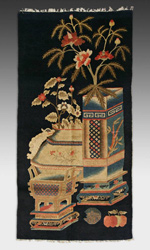 |
|
Baotou rugs have been compared to Chinese landscape paintings, and in particular, the Shan Shui style of painting, which depicts mountains, rivers and waterfalls. As one scholar named Ch'eng Hsi described it, "Shan Shui painting is not an open window for the viewer's eye – it is an object for the viewer's mind." The same could be said for Baotou landscape rugs. The ideal of Shan Shui painting was to capture the emotions, sensations and rhythms of nature rather than paint an exact representation of a scene. Baotou rugs have a similarly evocative nature allowing viewers to appreciate the mood of the rug as much as what it depicts.
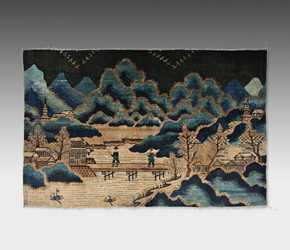 |
|
Earlier Baotou rugs depicted realistic images of animals, landscapes and objects placed in the center of the rug with repeated geometric motifs and borders. This format eventually evolved. Subjects began to occupy the entire surface area of rugs, and in many cases borders became nonexistent. Yet, some things scarcely changed. For example, the main color field was predominantly indigo blue, whereas rugs from Ningxia and Xinjiang used lighter, more neutral colors. The blue in Baotou rugs is striking, so deep that at times it can appear almost black. The Baotou dyers and weavers were masters of utilizing different shades of indigo. Oftentimes, it was the only color used. In some instances, reds and yellows complemented the indigo, further evoking images of scroll paintings.
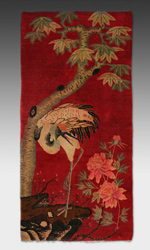 |
|
Collectors and art historians generally agree large exports of Chinese commercial rugs with oriental motifs began around 1890 in direct response to western demands. In fact, many factories were set up and run by foreign overseers. Natural dyes were replaced with aniline colors, weaves were coarse and designs became bland and predictable. However, in the years that followed rugs woven in Baotou remained faithful to traditional motifs, colors, and handmade construction. Over a century later they still demonstrate unsurpassed artistry. The general lack of awareness of Baotou rugs in the art world; their beauty, scarcity and impeccable construction have now elevated them from an underdog position among all types of Chinese art to a recognized champion.
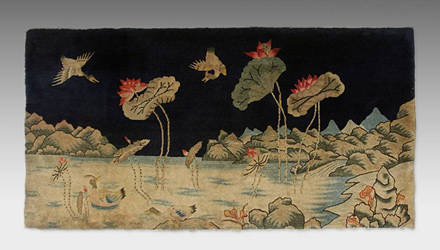 |